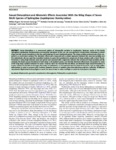Use este identificador para citar ou linkar para este item:
http://www.alice.cnptia.embrapa.br/alice/handle/doc/1036005Registro completo de metadados
| Campo DC | Valor | Idioma |
|---|---|---|
| dc.contributor.author | CAMARGO, W. R. F. de | pt_BR |
| dc.contributor.author | CAMARGO, N. F. de | pt_BR |
| dc.contributor.author | CORRÊA, D. do C. V. | pt_BR |
| dc.contributor.author | CAMARGO, A. J. A. de | pt_BR |
| dc.contributor.author | DINIZ, I. R. | pt_BR |
| dc.date.accessioned | 2016-02-03T11:11:11Z | pt_BR |
| dc.date.available | 2016-02-03T11:11:11Z | pt_BR |
| dc.date.created | 2016-02-03 | pt_BR |
| dc.date.issued | 2015 | pt_BR |
| dc.identifier.citation | Journal of Insect Science, v. 15, n. 1, 2015. | pt_BR |
| dc.identifier.uri | http://www.alice.cnptia.embrapa.br/alice/handle/doc/1036005 | pt_BR |
| dc.description | Abstract - Sexual dimorphism is a pronounced pattern of intraspecific variation in Lepidoptera. However, moths of the family Sphingidae (Lepidoptera: Bombycoidea) are considered exceptions to this rule. We used geometric morphometric techniques to detect shape and size sexual dimorphism in the fore and hindwings of seven hawkmoth species. The shape variables produced were then subjected to a discriminant analysis. The allometric effects were measured with a simple regression between the canonical variables and the centroid size. We also used the normalized residuals to assess the nonallometric component of shape variation with a t-test. The deformations in wing shape between sexes per species were assessed with a regression between the nonreduced shape variables and the residuals. We found sexual dimorphism in both wings in all analyzed species, and that the allometric effects were responsible for much of the wing shape variation between the sexes. However, when we removed the size effects, we observed shape sexual dimorphism. It is very common for females to be larger than males in Lepidoptera, so it is expected that the shape of structures such as wings suffers deformations in order to preserve their function. However, sources of variation other than allometry could be a reflection of different reproductive flight behavior (long flights in search for sexual mates in males, and flight in search for host plants in females). | pt_BR |
| dc.language.iso | por | pt_BR |
| dc.rights | openAccess | pt_BR |
| dc.subject | Dilophonotini | pt_BR |
| dc.subject | Geometric morphometric | pt_BR |
| dc.subject | Macroglossini | pt_BR |
| dc.subject | Philampelini | pt_BR |
| dc.title | Sexual dimorphism and allometric effects associated with the wing shape of seven moth species of Sphingidae (Lepidoptera: Bombycoidea). | pt_BR |
| dc.type | Artigo de periódico | pt_BR |
| dc.date.updated | 2016-02-26T11:11:11Z | pt_BR |
| dc.subject.nalthesaurus | sexual selection | pt_BR |
| riaa.ainfo.id | 1036005 | pt_BR |
| riaa.ainfo.lastupdate | 2016-02-26 | pt_BR |
| dc.identifier.doi | 10.1093/jisesa/iev083 | pt_BR |
| dc.contributor.institution | AMABILIO JOSE AIRES DE CAMARGO, CPAC. | pt_BR |
| Aparece nas coleções: | Artigo em periódico indexado (CPAC)  | |
Arquivos associados a este item:
| Arquivo | Descrição | Tamanho | Formato | |
|---|---|---|---|---|
| AmabilioSexualDimorphism.pdf | 813,32 kB | Adobe PDF |  Visualizar/Abrir |









